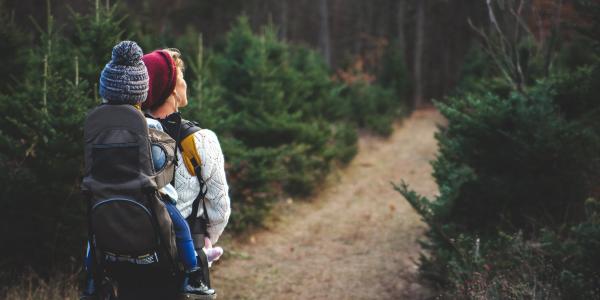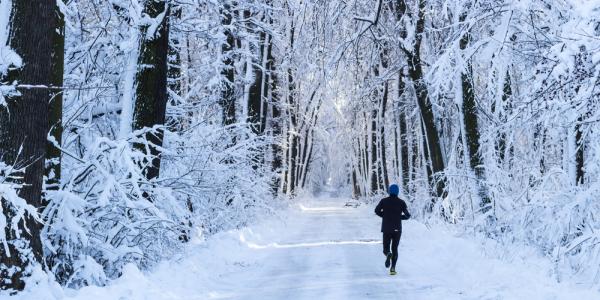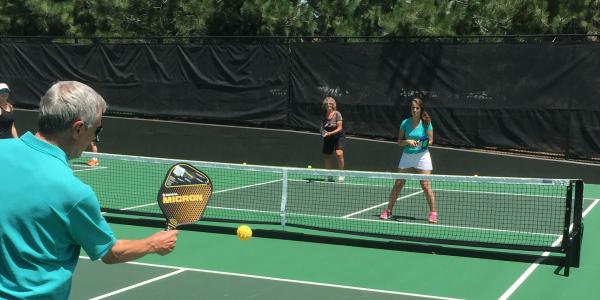Take a Hike!

Thinking about ways to get outside, get moving, and improve your health? Lace up those hiking shoes and head for the hills!
Although known as the ‘Great Lakes State’, it’s no secret that Michigan is home to a wealth of dry-land recreation opportunities. One of the more popular activities is hiking, and with good reason. Hiking is a great example of a vigorous-intensity activity that can help improve your physical wellbeing while centering the mind. It’s also an excellent choice for families, as hiking tends to be one of the more accessible and affordable outdoor hobbies that you can pursue. Whether you prefer rugged treks through dense woods, easy strolls across panoramic meadows- or something in between- there’s likely a trail for you.
While ‘hiking’ and ‘walking’ are similar, they are not synonymous. Because we tend to hike on uneven, sometimes hilly terrain, greater muscle recruitment is required to stay upright. This strengthens muscles and ligaments in the lower limbs that may otherwise go under-utilized. The higher cardio respiratory toll required to push forward is another bonus side effect of hiking on uneven surfaces. A 2013 University of Michigan study found that hiking on uneven terrain requires 28% more energy output than walking on flat ground.
In a 2017 study, a team from the University of Innsbruck measured and compared the efforts of participants hiking in the outdoors versus walking on treadmills. Scientists found that participants tended to push themselves harder on the hike, as heart rate averages were 6 BPM higher during the hike portion than the treadmill walk. Despite working harder on the hike, participants reported increased feelings of pleasure and less fatigue when compared to their treadmill effort. Simply put, hiking on the trail felt easier and more uplifting than walking on a treadmill, even if the hike was actually more physically demanding. For these participants, being in the outdoors made the work feel easier and ultimately more enjoyable.
Top Tips
• Hydrate! Snacks are important too, but be extra careful to pack enough water. Try to drink one liter (32oz) for every two hours spent hiking.
• Sunscreen and a wide-brimmed hat are great ways to combat the sun’s harmful rays. Bug spray is another nice addition to any hiking pack, especially in Michigan.
• Wear appropriate hiking shoes, boots, or sturdy athletic shoes. Blisters can turn a good hike sour in no time, so wear shoes that are broken-in, comfortable, and supportive.
• Take a close look at the trail map to familiarize yourself with the trail before heading out.
• Tell someone where you’re hiking and when you expect to return. Even better, find a friend to join you.
• Bring your cell phone. You may be tempted disconnect and set the phone to ‘silent’ (this is fine), but it could be invaluable in an emergency situation.
Where to hike
MSU Campus
Sanford Natural Area:
Located on the east side of campus, this wooded path along the Red Cedar River is perfect for a midday stroll. The Sanford Natural was originally named North Wood Lot when it was purchased in 1855. It was renamed Wood Lot 1 and River Wood Lot, before it was renamed Sanford Natural Area after Frank Hobart Sanford. The Red Cedar River runs along the North end of the floodplain forest, which takes up a total of 34 acres.
Baker Woodlot/ and Rajendra Neotrpoical Bird Sanctuary:
Rachana Rajendra was an Okemos resident who loved birds and nature. When a tragic automobile accident took her life in 1997, her parents established an endowment to honor her memory. The funds were used to create and maintain the Rachana Rajendra Neotropical Migrant Bird Sanctuary, located in the Baker Woodlot at Michigan State University. The Sanctuary is an urban refuge for people and birds alike. This small, but largely undisturbed deciduous forest provides the community with a special place to observe birds, conduct research, and explore nature along winding paths in a quiet wood. There are three entrances to the Sanctuary. Two can be found evenly spaced along the east fence on Bogue Street and one entrance is on Farm Lane near the northwest corner. A bike rack is located at each entrance; bikers are encouraged to leave their bicycles secured to the rack before entering the Sanctuary as bikes are not allowed within the enclosed area. Vehicle parking is most readily available on Bogue Street.
Nearby trips
Lake Lansing Park North:
Enjoy the wildlife and natural environment located within this 410-acre park. Lake Lansing Park North has approximately five miles of trails which wind through a surprisingly secluded area on the outskirts of the Lansing Metro area. A 2.4 mile loop of the trail system is marked with interpretive signs for easy accessibility. Trails and boardwalks provide access to evergreen forests, swamp, marsh, deciduous forest and fields in various stages of succession.
Harris Nature Center/Eastgate Park:
This linear hike follows a series of dirt, wood-chip, and paved trails. Start at either end of the trail, the Eastern terminus is located at Eastgate Park, the West at the end of Sylvan Glen Road (both in Okemos). The trail follows the Red Cedar River in areas and may be prone to flooding in the spring. There are handful of smaller trails that veer from the main path, but the trail network is generally well-marked and easy to navigate. The trail passes through the Harris Nature Center, a popular family destination.
Fenner Nature Center
Fenner Nature Center is home to over 4 miles of hiking trails, two of which are paved and handicapped-accessible. The trails will take you to points of interest like the "Sugar Bush," the butterfly garden, a glacial esker (a long, winding ridge of stratified sand and gravel), and observation decks overlooking three ponds.
Burchfield Park
Enjoy six miles of trails and hundreds of feet of boardwalk in this 540 acre park located south of Lansing. The park invites exploration of mature forests, gentle creeks, a pond, wooded flood plains, and a thriving riparian habitat along the Grand River. Three trailheads provide access to the trail system; one at Burchfield Park, one at Riverbend Natural Area, and one at McNamara Landing. Keep an eye out for bikes during the summer months, as bicycles are permitted on the trails when conditions allow.
Within an hour’s drive:
Sleepy Hollow State Park
This quiet State Park a hidden gem, located a short drive north of Lansing on US 127. The main trail is mixed use (hikers and bikes), and grants access to a nice variety of habitat and wildlife viewing. Over 13 miles in length, the main trail transitions between areas of wooded cover, marshy lowlands, and open fields. The section south of Price Road is a bit rougher, with some short but steep climbs and rockier terrain.
Hidden Lake Gardens
‘Under the radar’ may be an understatement when it comes to this southern Michigan treasure. Hidden Lake Gardens is a botanical garden and arboretum operated by MSU. The Gardens are known for their large collection of native and nonnative trees, shrubs and flowers. The gardens feature 6 miles of hiking trails, but that’s just the start. Check out the 8,000 square foot conservatory, the Harper collection of rare and dwarf conifers, hosta hillside, the demonstration garden, and one of the largest bonsai collections in the Midwest (some of the bonsai’s in the collection are 100 years old!)
Brighton Recreation Area Trails
Scattered throughout the 4,947-acre Brighton Recreation Area are 10 small lakes that were the result of retreating glaciers. Take in these lakes (and more) as you hike a 12.3 mile loop trail. Located near Brighton, this hike is rewarding but challenging- it is rated as ‘difficult’. The trails system includes 8.5 miles of paths designated for hikers only. The Penosha Trail is a fun 5-mile loop through the wooded hills and wetlands in the heart of the park.
Potawatomi Trail, Pinckney State Recreation Area:
Locals call it the “Poto”, and this 17 mile loop trail is a Southeast Michigan bucket-lister. One of the oldest and longest loops in the area, the Potawatomi is popular among hikers and mountain bikers alike. Park at Silver Lake Beach for easy access to the trailhead. Glacial hills and Michigan deciduous forest set the backdrop, and you’re likely to notice eskers and glacial erratics (large rocks that were transported by a glacier, then left behind after the glacier melted) throughout the hike. There are several lakes and some streams, with wooden bridges serving as water crossings. Moderate-to-challenging difficulty, depending on conditions.
Now get outside and enjoy some of Michigan’s exceptional hiking! For additional resources, classes and upcoming events, visit MSU Moves online at http://health4u.msu.edu/msu-moves
Works Cited
http://www.latimes.com/science/sciencenow/la-sci-sn-nature-mental-health-20150629-story.html
http://www.pnas.org/content/112/28/8567
https://www.ncbi.nlm.nih.gov/pmc/articles/PMC4236228/
http://journals.plos.org/plosone/article?id=10.1371/journal.pone.0177719
Related Articles

It's Winter. Time to Get Out and Go For a Run!
Book Review: Running is My Therapy: Relieve Stress and Anxiety, Fight Depression, Ditch Bad Habits, and Live Happier

Embrace the Elements and Get Outside this Winter
With a little planning and a good attitude, you can stay active outside this winter- and actually enjoy it!

Join Team MSU for the 2018 Capital City River Run Half Marathon/5K Corporate Challenge, Receive Free Personalized Coaching!
Want to walk or run your first 5k? How about achieving a new PR in the Half-Marathon? Whatever your goal or fitness level, MSU Moves can help you get there!

Pickleball: Funny Name, Serious Game
Pickleball may be the fastest-growing sport in America. This mix of tennis, badminton and ping-pong is a great workout that rewards player's skill and tact, rather than athleticism. Learn more about the game and how you can participate!





